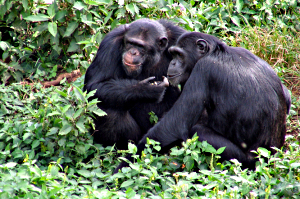 Photo by: Melissa Batson
Photo by: Melissa Batson
And how they put a snare in the plan for chimps and humans to live together.
In the Budongo Forests of Uganda, a large group of Chimpanzees, named by researchers The Sonso Group, attempt to thrive in their natural habitat, eating plants and small prey. At the same time, humans who live around the forest are also trying to survive, working at places like the local sugarcane plantation and living in straw and mud houses. For food, they set out into the forest with small snares and aim for duiker and or pig.
Most of these snares are made from wire. As chimpanzees walk through the forest, their hands or feet may become trapped in the snare. In two of the forests where chimpanzees are studied, researchers have observed up to 25 percent of chimpanzees are maimed due to snare injuries. More die.
This problem is typical all over the world. How do the chimps and people live together? How do elephants and people live together? Wolves and people? Mountain Lions and Bay Area people? Though solutions seem impossible at times, I am impressed by many of the solutions, one being that of the Budongo Snare Removal Project.
